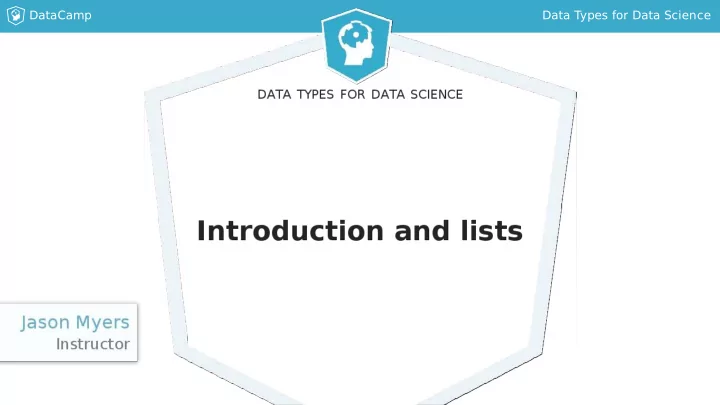

DataCamp Data Types for Data Science
DataCamp Data Types for Data Science Data types Data type system sets the stage for the capabilities of the language Understanding data types empowers you as a data scientist
DataCamp Data Types for Data Science Container sequences Hold other types of data Used for aggregation, sorting, and more Can be mutable (list, set) or immutable (tuple) Iterable
DataCamp Data Types for Data Science Lists Hold data in order it was added Mutable Index In [1]: cookies = ['chocolate chip', 'peanut butter', 'oatmeal', 'sugar'] In [2]: cookies.append('Tirggel') In [3]: print(cookies) ['chocolate chip', 'peanut butter', 'oatmeal', 'sugar', 'Tirggel'] In [4]: print(cookies[2]) oatmeal
DataCamp Data Types for Data Science Combining Lists Using operators, you can combine two lists into a new one In [1]: cakes = ['strawberry', 'vanilla'] In [2]: desserts = cookies + cakes In [3]: print(desserts) ['chocolate chip', 'peanut butter', 'oatmeal', 'sugar', 'Tirggel', 'strawberry', 'vanilla'] .extend() method merges a list into another list at the end
DataCamp Data Types for Data Science Finding and Removing Elements in a List .index() method locates the position of a data element in a list In [1]: position = cookies.index('sugar') In [2]: print(position) 3 In [3]: cookies[3] 'sugar' .pop() method removes an item from a list and allows you to save it In [1]: name = cookies.pop(position) In [2]: print(name) sugar In [3]: print(cookies) ['chocolate chip', 'peanut butter', 'oatmeal', 'Tirggel', 'Biscotti', 'digestive', 'fortune']
DataCamp Data Types for Data Science Iterating and Sorting for loops are the most common way of interating over a list In [1]: for cookie in cookies: ...: print(cookie) chocolate chip peanut butter oatmeal Tirggel Biscotti digestive fortune sorted() function sorts data in numerical or alphabetical order and returns a new list In [1]: print(cookies) ['chocolate chip', 'oatmeal', 'Tirggel', 'Biscotti', 'digestive', 'fortune'] In [2]: sorted_cookies = sorted(cookies) In [3]: print(sorted_cookies) ['Biscotti', 'Tirggel', 'chocolate chip', 'digestive', 'fortune', 'oatmeal']
DataCamp Data Types for Data Science DATA TYPES FOR DATA SCIENCE Let's practice!
DataCamp Data Types for Data Science DATA TYPES FOR DATA SCIENCE Meet the Tuples Jason Myers Instructor
DataCamp Data Types for Data Science T uple, T uple Hold data in order Index Immutable Pairing Unpackable
DataCamp Data Types for Data Science Zipping and Unpacking Tuples are commonly created by zipping lists together with zip() Two lists: us_cookies , in_cookies In [1]: top_pairs = zip(us_cookies, in_cookies) In [2]: print(top_pairs) [('Chocolate Chip', 'Punjabi'), ('Brownies', 'Fruit Cake Rusk'), ('Peanut Butter', 'Marble Cookies'), ('Oreos', 'Kaju Pista Cookies'), ('Oatmeal Raisin', 'Almond Cookies')] Unpacking tuples is a very expressive way for working with data In [1]: us_num_1, in_num_1 = top_pairs[0] In [2]: print(us_num_1) Chocolate Chip In [3]: print(in_num_1) Punjabi
DataCamp Data Types for Data Science More Unpacking in Loops Unpacking is especially powerful in loops In [1]: for us_cookie, in_cookie in top_pairs: ...: print(in_cookie) ...: print(us_cookie) Punjabi Chocolate Chip Fruit Cake Rusk Brownies # ..etc..
DataCamp Data Types for Data Science Enumerating positions Another useful tuple creation method is the enumerate() function Enumeration is used in loops to return the position and the data in that position while looping In [1]: for idx, item in enumerate(top_pairs): ...: us_cookie, in_cookie = item ...: print(idx, us_cookie, in_cookie) (0, 'Chocolate Chip', 'Punjabi') (1, 'Brownies', 'Fruit Cake Rusk') # ..etc..
DataCamp Data Types for Data Science Be careful when making tuples Use zip() , enumerate() , or () to make tuples In [1]: item = ('vanilla', 'chocolate') In [2]: print(item) ('vanilla', 'chocolate') Beware of tailing commas! In [1]: item2 = 'butter', In [2]: print(item2) ('butter',)
DataCamp Data Types for Data Science DATA TYPES FOR DATA SCIENCE Let's practice!
DataCamp Data Types for Data Science DATA TYPES FOR DATA SCIENCE Sets for unordered and unique data Jason Myers Instructor
DataCamp Data Types for Data Science Set Unique Unordered Mutable Python's implementation of Set Theory from Mathematics
DataCamp Data Types for Data Science Creating Sets Sets are created from a list In [1]: cookies_eaten_today = ['chocolate chip', 'peanut butter', ...: 'chocolate chip', 'oatmeal cream', 'chocolate chip'] In [2]: types_of_cookies_eaten = set(cookies_eaten_today) In [3]: print(types_of_cookies_eaten) set(['chocolate chip', 'oatmeal cream', 'peanut butter'])
DataCamp Data Types for Data Science Modifying Sets .add() adds single elements .update() merges in another set or list In [1]: types_of_cookies_eaten.add('biscotti') In [2]: types_of_cookies_eaten.add('chocolate chip') In [3]: print(types_of_cookies_eaten) set(['chocolate chip', 'oatmeal cream', 'peanut butter', 'biscotti']) In [4]: cookies_hugo_ate = ['chocolate chip', 'anzac'] In [5]: types_of_cookies_eaten.update(cookies_hugo_ate) In [6]: print(types_of_cookies_eaten) set(['chocolate chip', 'anzac', 'oatmeal cream', 'peanut butter', 'biscotti'])
DataCamp Data Types for Data Science Removing data from sets .discard() safely removes an element from the set by value .pop() removes and returns an arbitrary element from the set (KeyError when empty) In [1]: types_of_cookies_eaten.discard('biscotti') In [2]: print(types_of_cookies_eaten) set(['chocolate chip', 'anzac', 'oatmeal cream', 'peanut butter', 'biscotti']) In [3]: types_of_cookies_eaten.pop() 'chocolate chip' In [4]:types_of_cookies_eaten.pop() 'anzac'
DataCamp Data Types for Data Science Set Operations - Similarities .union() set method returns a set of all the names ( | ) .intersection() method identifies overlapping data ( & ) In [1]: cookies_jason_ate = set(['chocolate chip', 'oatmeal cream', ...: 'peanut butter']) In [2]: cookies_hugo_ate = set(['chocolate chip', 'anzac']) In [3]: cookies_jason_ate.union(cookies_hugo_ate) set(['chocolate chip', 'anzac', 'oatmeal cream', 'peanut butter']) In [4]: cookies_jason_ate.intersection(cookies_hugo_ate) set(['chocolate chip'])
DataCamp Data Types for Data Science Set Operations - Differences .difference() method identifies data present in the set on which the method was used that is not in the arguments ( - ) Target is important! In [1]: cookies_jason_ate.difference(cookies_hugo_ate) set(['oatmeal cream', 'peanut butter']) In [2]: cookies_hugo_ate.difference(cookies_jason_ate) set(['anzac'])
DataCamp Data Types for Data Science DATA TYPES FOR DATA SCIENCE Let's practice!
Recommend
More recommend